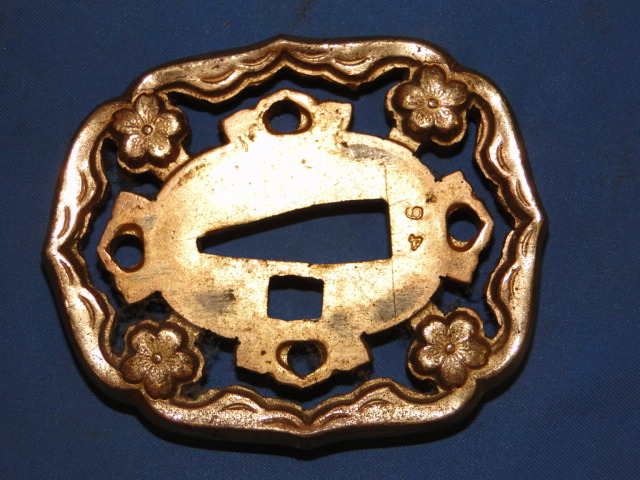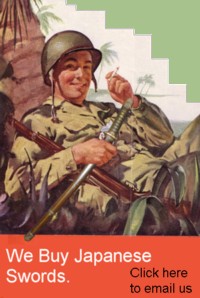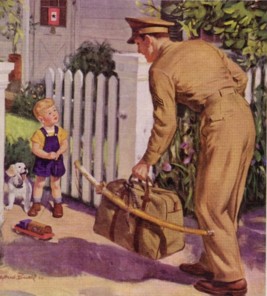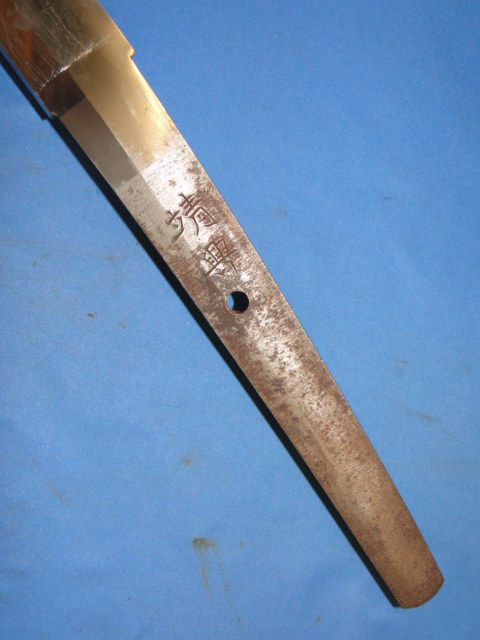SAMURAI WWII KATANA SWORD 54 - YASU OKI
This is a Japanese WWII Katana sword. Manufactured in 1942 by swordsmith yasu Oki. The overall sword is in very good condition.
Outfitted in WWII attire. The handle, scabbard and all of its components are correct for the period.

The handle shows the classicla WWII green cloth wrapping. A three flower menuki is present on each side. The three flowers were
the standard Menuki during WWII. White ray skin is used as background. The texture of the skin shows a series of small bumps. A
wooden base is employed.
The pommel is made of copper and has the Chrysanthemum flower with a leaf to each side. This pattern is found on front, top and back
of the pommel. The same pattern is also reflected at the base of the handle, in a metal piece known as the Fuchi. The sides of the
pommel are open and expose ray skin. at about mid-point is a circular opening where the lanyard loop is placed. There is no loop
shown on this example.

The multiple pieces pieces that surround the Tsuba are shown in the photo below. The Tsuba is showcased in the center and is
flanked by washers. Some of the pieces have a two digit number stamped on them. This is a production number applied by the
factory.

The Tsuba has a hollowed body. This characteristic indicates that it was created during the early days of the war. In later
years the body was solid. There was no time to assign resources to make the tsuba look better. A production number is
stamped on one side.


|
The Samurai sword has a very rich history. The sword has been manufactured for several centuries and continues
to be produced today. The sword represented more than just a weapon. It was the soul of the Samurai warrior.
When attempting to identify the type of sword you have It is important to keep in mind that the fittings of
a sword (scabbard, handle, crossguard. etc.) may be identical from one sword to another. The reason why is
because during WWII the same fittings were used in all Army swords, Navy swords, etc. Armed forces are all
about uniformity. They strive to make everything the same.
This is the reason why a sword cannot be identified merely by its external appearance.
Understanding the different components that make up the Samurai sword is the first step in figuring out the
type of sword you have. That is the reason why we have created the
Understanding the Samurai sword section as a means to
provide a novice with the basic knowledge to start the path of determining the questions everyone has;
who made the sword, how old it is nad how much it is worth.
|

The scabbard has a suspension ring attached near the throat. Two copper bands are employed to attach it to the main body.
A two tier, flower pattern, is stacked just below the ring. The ring was used as a means to attach the sword to the belt
assembly that allowed the soldier to carry it.
The two photographs that follow show the locking mechanism and the numbers that have been stamped on them.


|
This page is a recognition and identification guide for Samurai swords.
Multiple detailed photos of a specific sample are provided. Descriptions point
out clearly defined points that should be noted.
One of the most commonly asked questions is "How much is my Samurai Sword worth?".
A price guide is included here to address this question. The value of the swords is
reviewed over a period of several years. A trend can be observed. The present worth
of the edge weapons in the collector's market is illustrated.
This service is provided free of charge to the visitor/enthusiast courtesy of
MilitaryItems.com,
a company dedicated to the preservation of military history and to providing quality
military antiques and collectibles to museums, institutions and the general public.
|
|


The Habaki of the sword is standard WWII type. Copper construction with vertical lines. The washers and Tsuba have a hole that
allow the locking tab to pass through, as it is visible in the above photograph.
The mouth of the handle is made of wood and also reflects the same numbers found on the other components of the sword.

The tang has markings on both sides. one side reflects the date while the other is the signature of the swordsmith.


|
WE BUY JAPANESE SWORDS - All types of Japanese edge weapons. Whether it is a WWII era Samurai sword or an
older type of blade.
The process gets started by you sending us an
Email .
We will respond to your inquiry normally within 24 hours and in many cases much faster.
We can tell you what you have, what it is worth and how much we can pay you.
One sword or an entire collection -
Email Us .
|
 |

The date is clearly stamped on one side of the tang. The sword was created during the Showa period, which is consistent for
WWII. The swordsmith stamped October of 1942.

The signature is applied to the other side of the tang. It consists of two characters that read Yasu Oki. The swordsmith
was a medium grade master during WWII.

The top of the tang has the shape knwon as Kuri Jiri with a rounded slope. The correct patina for the age is also found in this
part.


The point of the blade is known as Chu. This was the most common type produced during WWII and other time periods. The
lines of the tip are very well defined.


By the Numbers
It is next to impossible to determine the exact number of Samurai swords that were produced and issued to
Japanese soldiers during the war. However, thanks to the record keeping maintained by the US Armed Forces,
it is possible to estimate how many swords were actually shipped home.
 |
There were over 500,000 Samurai swords were brought back home as souvenirs from the war.
There are several caviats to this number.
|
 |
For example, some soldiers took souvenirs and shipped them home circumbenting the established process.
Some of the swords were brought back inside duffle bags without anyone knowing except for the soldier who
captured the sword. This fact would clearly affect the final count.
The number also does not account for swords that were taken by Allied soldiers from other countries.
Collecting Samurai swords
Collecting Samurai swords is a field that has been growing since the days the GI's rummaged around Asia
bringing back military souvenirs. Japanese soldiers carried many of these swords when they went to
battle. Once the soldier was killed or captured, the Americans would take the edge weapons as war trophies.
Eventually all these pieces came back to the United States where military history enthusiasts began to collect them.
 |
In trying to determine if you should collect Samurai swords there are certain factors that should be
considered.
The adjacent table outlines some of the advantages and disadvantages of collecting the Samurai swords.
|
 |
This Samurai Sword may be currently reproduced.
It is becoming more difficult to be able to tell the fake ones from the real ones because
the quality of the reproductions is improving. The collector must become familiarized with
the construction style and materials employed in the manufacturing of this item.
Attention to the details is critical in order to be able to determine the authenticity of
the collectible.
If you have an interest is seeing other Japanese Samurai swords, you can do so by going to our
Japanese Samurai Swords Price Guide
identification guide. Where we cover Samurai swords from all periods.
| 




